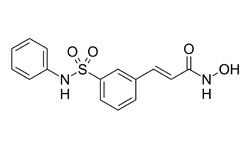Phase I/II Data Shows Belinostat Could Provide Benefit for Patients in STS
Belinostat (PXD101), in combination with doxorubicin, could provide benefit for patients with soft tissue sarcomas, according to final results from the first stage of the phase II portion of the phase I/II CLN-14 clinical trial.
Chemical structure of belinostat

Belinostat (PXD101), in combination with doxorubicin, could provide benefit for patients with soft tissue sarcomas, according to final results from the first stage of the phase II portion of the phase I/II CLN-14 clinical trial. The results from this study come from Topotarget, the Scandinavian-based biopharmaceutical company developing the drug. The study of 47 patients was conducted at three sites: two in Denmark and one in the United Kingdom.
In the phase I dose escalation portion of this study, belinostat was well tolerated in patients with advanced solid tumors on a three-week schedule at the dose of 1000 mg/m2on days 1-5 in combination with 75 mg/m2doxorubicin on day 5. In this dose escalation phase of the study, 18 of 25 patients (72%) achieved disease control and 12 remained in disease control at 3 months. In this cohort, the median time to progression was 3.7 months.
Once the maximum tolerated dose was established, 20-40 patients were enrolled in the dose expansion (phase II) portion of the study, according to the design of the trial. In the dose expansion phase, 11 of 16 patients (69%) achieved disease control, with 8 remaining in disease control at 3 months. In this phase, the median time to progression observed was 6 months. In addition, 4 objective responses were seen, including 1 complete response, and 25 patients achieved disease stabilization.
Belinostat is a histone deacetylase (HDAC) inhibitor and has demonstrated the ability to both inhibit cell proliferation and induce apoptosis in tumor cells.
Across all clinical trials, over 1000 patients have received and tolerated belinostat. Compared with other inhibitors of HDAC, belinostat’s preliminary safety data have demonstrated lower incidences of grade 3-4 adverse events. The most commonly reported adverse events associated with belinostat across all clinical trials have been nausea, fatigue, diarrhea, and vomiting.
“Further development of belinostat in this indication would require a randomized trial,” according to a statement from Topotarget. “The final results from CLN-14 will be a part of the strategic evaluation of the further development of belinostat.”








